Product Categories
SHOP BY ARTIST
NEWSLETTER
Products

Navajo Sterling Silver Lightning Arrow Bracelet - Allison Lee (#188)
$880.00
Artist: Allison Lee
Total inner circumference including opening: 7"
Opening: 1 1/4"
To reinforce the ideal that the Bearer of the Sun has an arsenal of incredibly powerful weapons, Allison Snowhawk Lee has crafted a bracelet depicting a most dramatic lightning arrow. Only the most powerful deities harness the greatest forces of the natural world. Only Allison has this unique way of presenting the myth and legend of his people through metal art.
About the artist:

Allison Lee - Navajo Silversmith:
Speaking of the silver and gold jewelry he hand crafts, Allison Lee's captivating voice is sincere when he says, "One time my uncle told me that everything we build comes from the earth, like the silver that comes from the earth, or the turquoise that comes from the earth. That is a lot of energy. You put it together and you put your heart and mind into a piece. Then sometimes a certain piece of jewelry- I believe- it is made for a certain person. I usually have a ring, or something, that stays with me for about two or three years, until the right person comes along. And then that person buys that piece. I believe that every piece of jewelry that I make is made for somebody out there- it's made for somebody special. Whoever might be having problems, or something like that. In essence, that energy helps that person get help, by wearing pieces that we make. That is the way I look at it.
Related legends:
Arrows
To the Navajo, flint is a sacred stone. Arrowheads are said to resemble the tips of the fiery bolt thrown by Thunder. Arrows equal lightning and some of the old warrior tales tell of mortals who wear flint armor and look like Gila Monster. In other legends, when Elder Brother sings flint songs, his voice jingles with the sound of blue flint, thunder flint, water flint, talking flint?

Navajo Sterling Silver Naja Coral Necklace (#46)
$710.00
Navajo Jewelry
Necklace: 24"
Pendant: 1 3/4" x 2 1/4"
Sterling silver, hand-made beads, blood red Mediterranean coral, horseshoe naja and Navajo construction combine to make for one sweet set. This combination of stone and metal speak history, Navajo culture and good value all at the same time.
We offer a 100% satisfaction guarantee on every purchase.
Related legends:
Silversmith Work
When and how the Navajo acquired the art of working metals is unknown but there are reasons for supposing that it was introduced among them, or at least more developed and improved upon by them, since the time they have occupied their present country?

Navajo Sterling Silver Natural High-Grade Bisbee Turquoise Ring - Will Denetdale (#266)
$420.00
Artist: Will Denetdale
Size: 9
Most people believe Bisbee turquoise must have a chocolate matrix. Au contraire mon ami! This cabochon of high-grade natural Bisbee turquoise disproves that conception. The depth of color and character of this stone is stunning. Will Denetdale has set this Bisbee cab in an intricate, yet subtle setting that brings it to life. Will was the perfect man for the job.
Bisbee Turquoise
Bisbee turquoise jewelry is highly coveted by collectors worldwide. The signature look for Bisbee turquoise is a dark lavender blue color with a deep chocolate brown to black matrix. Some of the most distinctively recognizable Indian jewelry has been set and photographed containing classic Bisbee turquoise. As with all turquoise, there is a wide variety of quality from the Bisbee mine where color and matrix patterns can vary a great deal.
The most productive period of the Bisbee turquoise mine was the 1950's and 1960's. The mine has been closed since the early 1970's and is currently owned by Phelps Dodge Corp. Bisbee Mine. Arizona, Cochise County. Turquoise is a copper compound and, in the case of the Bisbee mine, is found in the open pit copper mine known as the Lavender Pit. At this mine, it is typically found as stringers up to a few inches wide; as small nugget-like masses in granite and quartzite; or as minute stringers in massive pyrite.
About the artist:

Will Denetdale - Navajo Jewelry:
One of the most talented Navajo gold and silversmiths currently producing jewelry, Will Denetdale is making an indelible mark in the world of Native American art. His name is becoming famous in his trade; his art a standard by which other pieces may be judged. Will's success as an artist is proportionate to his devotion, and Will Denetdale lives to make jewelry.
Related legends:
Silversmith Work
When and how the Navajo acquired the art of working metals is unknown but there are reasons for supposing that it was introduced among them, or at least more developed and improved upon by them, since the time they have occupied their present country?

Navajo Sterling Silver Natural Kingman Turquoise Pendant - Albert Jake (#63)
$450.00
Artist: Albert Jake
1 1/4" x 2 1/4"
Albert Jake has taken a classic example of high grade, natural Kingman turquoise and placed it in a hand-made sterling silver setting befitting it's quality. Traditional designs, drawn from the natural world, surround and embrace the stone. Deer tracks, raindrops, entangled vines and rays of sunlight grace the setting. What better manner to present this marvelous piece of sky stone?
Kingman Turquoise
Kingman Turquoise comes from a large open-pit copper mine in the Mineral Park Mining District, northwest of Kingman, Arizona and was one of the largest turquoise mines in this country. The area lies in high desert country at an elevation of 3,345 feet and is surrounded by three mountain ranges. The mining district around Kingman, Arizona has always been a large producer of turquoise, at one time the world's largest. First mined by Indians, this area was home to the most extensive prehistoric workings found in Arizona.
The modern production of turquoise dates back to the early 1880’s when James Haas rediscovered these ancient Kingman area mines. Much of the turquoise occurred as seams, masses and veins. The color of natural Kingman turquoise can range from light blue to very dark blue and sometimes tints of green. The matrix is from white, light brown to black and frequently flecked with pyrite and times quartz. The mine became famous for its rounded, bright blue nuggets with black matrix. Few turquoise mines produced nuggets, especially of this quality. In its high-grade form it has always been considered among the top quality American turquoise. With so many thousands of pounds of good quality turquoise produced in the Kingman area over the last one hundred years it is hard to believe that today very little high-grade Kingman turquoise is available.
Other names for Kingman turquoise: Ithaca Peak, The Wall, Tiffany, Courtland, Az., Gleeson
Most desirable: Deep Blue with molybdenum pyrite; Real blue with pyrite; Bird's eye; Water Web; Nuggets
About the artist:
Since 1959, Albert Jake has made his home in the beautiful country located about forty miles south of Gallup, New Mexico. He was born at Zuni Pueblo and has resided in the village of Ramah for many years. Albert’s parent taught him the many steps to fine Navajo silverwork which includes both cluster jewelry as well as beautiful stones in classic Navajo settings.
Related legends:
Precious Stones Turquoise; Precious stones have symbolic implications. For example, turquoise if a "collective term for all the precious stones, wealth, or mixed offerings. Good fortune is attributed to this stone." Both white shell and turquoise are emphasized in Kinaalda? More about this legend

Navajo Sterling Silver Plain Bead Bracelet - Allison Lee (#179)
$468.00
Artist: Allison Lee
Navajo Jewelry
Inner Circumference: 6 1/4"
Opening: 1 1/2"
Total: 7 3/4"
When it comes to Southwest jewelry, men almost always get left out. Although we work hard to find good stuff for our male counterparts, there just is never enough. That is the reason Allison Lee has designed this precisely simple bracelet for us. Elegant, uncluttered and easily wearable every day, this is the cuff we have all been looking for.
We offer a 100% satisfaction guarantee on every purchase.
About the artist:

Allison Lee - Navajo Silversmith:
Speaking of the silver and gold jewelry he hand crafts, Allison Lee's captivating voice is sincere when he says, "One time my uncle told me that everything we build comes from the earth, like the silver that comes from the earth, or the turquoise that comes from the earth. That is a lot of energy. You put it together and you put your heart and mind into a piece. Then sometimes a certain piece of jewelry- I believe- it is made for a certain person. I usually have a ring, or something, that stays with me for about two or three years, until the right person comes along. And then that person buys that piece. I believe that every piece of jewelry that I make is made for somebody out there- it's made for somebody special. Whoever might be having problems, or something like that. In essence, that energy helps that person get help, by wearing pieces that we make. That is the way I look at it.
See full biography
Related legends:
Silversmith Work
When and how the Navajo acquired the art of working metals is unknown but there are reasons for supposing that it was introduced among them, or at least more developed and improved upon by them, since the time they have occupied their present country?

Navajo Sterling Silver Sleeping Beauty Turquoise Cluster Bracelet - Eugene Livingston (#142)
$850.00
Artist: Eugene Livingston
Total inner circumference including opening: 6 1/8"
Opening: 1"
Although he does not produce jewelry in large quantities, each piece that Navajo silversmith Eugene Livingston makes is precisely executed. Possibly his favorite style is turquoise cluster work. When it comes to bracelets like this, Eugene does everything from cutting the stones to soldering the silver. This is traditional silversmith work at its best.
Sleeping Beauty Turquoise
The Sleeping Beauty turquoise mine is located seven miles from Globe, Arizona. The mine is one of the largest producers of turquoise in North America. The mine, and the turquoise extracted from it, derives its name from Sleeping Beauty Mountain, which at one time was part of the Copper Cities operation. The center of the copper mine is located at approximately 33o24"13.23"N. 110o53'34. 60"W, at an elevation of 1224 feet. Sleeping Beauty Turquoise Mining is presently owned and operated by Monty Nichols.
For many centuries before the first Europeans made their way into Arizona, turquoise was being mined on the slopes of Sleeping Beauty Mountain. The Salado and other ancient peoples mined the beautiful sky stone from several surface outcroppings located in the vicinity, including Pinto Valley. It is believed that Spanish explorers were the first Europeans to locate the source of Sleeping Beauty sometime around the 1860s. By the 1870s, small underground mines pockmarked the hills surrounding present day Globe.
Cities Service Company started the Copper Cities Mine (commonly called the Sleeping Beauty Mine) in 1952 and operated it until the Pinto Valley mine opened in 1972. During the 1960s, L.W. Hardy had the contract to mine turquoise, both at Sleeping Beauty and at Castle Dome, later called the Pinto Valley Mine. Formerly a meat cutter at a market in Miami, Hardy recognized early on that turquoise was more valuable as a gemstone than the associated copper.
By the time the turquoise boom began, Hardy had contracts with mining companies in Miami, Kingman and elsewhere. He also developed a method for stabilizing low-grade, porous turquoise with pressure-impregnated hot acrylic resin, which hardened the stone and improved the color.
Hardy's mining methods were primitive when compared with current operations. Hardy's workers sat in a ditch ripped by a bulldozer and hand picked the stone from waste-rock. Hardy mined turquoise at Sleeping Beauty for 22 years, getting about 45 percent recovery, and leaving the rest in waste dumps.
Monty Nichols received the contract to mine Sleeping Beauty turquoise in 1988, and began using modern mining methods to develop the property. Nichols drills and blasts the overburden, hauling it to the abandoned Copper Cities pit, which now contains the recycled tailings from Miami Copper Company's No. 5 tailing dam. The old dam dominated the eastern skyline of downtown Miami until recently. The year Nichols acquired the contract; he began a two-year project to remove 5,000.000 tons of overburden. Located half way up the side of an open pit mine, the narrow turquoise-bearing zone has about 400 feet of hard waste rock on top of it. In order to move sideways into the ore-body, a whole slice of the mountain had to be removed.
To avoid fracturing the turquoise, Nichols was careful not to blast too near the turquoise-bearing strata. That layer is more crumbly, so the miners can rip it and dump it over screens, separating the material by size. No crushers are used, again to avoid fracturing the gemstone, and the different sized rock is hauled up to a wide mine bench where conveyor belts move the material through three buildings. There, workers handpick turquoise from the broken rock. The buildings are vented with filtered air to eliminate workers' exposure to dust, and well insulated to keep them comfortable in any weather. It is a far cry from the old methods of mining. Anywhere from 30 to 40 people work at the mine at any one time, depending on how much mining there is to do.
Fifty years ago, mine workers filled lunch buckets with the colorful rock, even though it was reason for immediate termination. Old habits die hard, and some people still think it is okay to sneak in and try to pick turquoise. As a result, security is tight in and around the mine. Motion detectors, night vision cameras and 24/7 roving patrols are used, so the only turquoise leaving the property now is being shipped to markets around the world.
Italy is the largest volume buyer of Sleeping Beauty turquoise, with Germany and Hong Kong following closely behind. These customers buy the best grade for their exclusive jewelry. Jewelry makers in India and Spain also receive Sleeping Beauty turquoise, while in the U.S., Gallup and Albuquerque are the largest consumers.
The Sleeping Beauty turquoise mine produces a uniform light to medium blue turquoise with rare finds of deep, dark blue. Because of its uniformity, it has been a favorite of the Zuni Pueblo. Zuni silversmiths often use it in channel inlay and various types of cluster work that require large numbers of small, perfectly matched stones. The Sleeping Beauty mine has been one of the larger producers of rough turquoise in the United States, although today much less good turquoise is being produced than in the past.
Sleeping Beauty turquoise is noted for its solid, light blue color with no matrix; the host rock is usually granite. Nichols says the mine is producing about 1,600 pounds a month. Of that, only four percent is natural; most of the turquoise from the mine is altered in some way. Most is enhanced, which is more expensive than stabilization, and sold to large distributors in this country and Europe. Currently most of the turquoise that comes from the mine is from the tons of tailings piles that have been accumulating for decades.
The best of the Sleeping Beauty turquoise is comparable to that found in the Middle East. It is thought that large quantities of Sleeping Beauty turquoise is taken overseas and smuggled into, then out of, Iran to be sold as “Persian” turquoise.
About the artist:

Eugene Livingston - Navajo Jewelry
Eugene is one of those rare artists who has mastered not just one or two methods, but a myriad of jewelry techniques. As a young man, he trained under other talented silversmiths After many decades of steady work, Eugene is skilled at metal fabrication, casting, making his own silver ingots, and most importantly for his work, the ability to cut stones. In his work below, you will see beautiful cut teardrop and pyramid cut Sleeping Beauty turquoise and coral. His two newest pieces with Carico Lake turquoise demonstrate his mastery of silver stamp work.
Related legends:
Silversmith Work
When and how the Navajo acquired the art of working metals is unknown but there are reasons for supposing that it was introduced among them, or at least more developed and improved upon by them, since the time they have occupied their present country?

Navajo Sterling Silver Sleeping Beauty Turquoise Cluster Brooch - Eugene Livingston (#140)
$490.00
Artist: Eugene Livingston
Navajo Jewelry
2 1/4" x 2 1/4"
Cluster jewelry is emblematic of the Navajo people, and Eugene Livingston is a craftsman who about that. Eugene makes cluster pins, which are balanced and beautiful. Just have a look at this one. Using Sleeping Beauty turquoise from the Inspiration copper mine, Eugene creates inspiring old style pieces. Get this one on.
We offer a 100% satisfaction guarantee on every purchase.
About the artist:

Eugene Livingston - Navajo Jewelry
Eugene is one of those rare artists who has mastered not just one or two methods, but a myriad of jewelry techniques. As a young man, he trained under other talented silversmiths After many decades of steady work, Eugene is skilled at metal fabrication, casting, making his own silver ingots, and most importantly for his work, the ability to cut stones. In his work below, you will see beautiful cut teardrop and pyramid cut Sleeping Beauty turquoise and coral. His two newest pieces with Carico Lake turquoise demonstrate his mastery of silver stamp work.
Related legends:
Silversmith Work
When and how the Navajo acquired the art of working metals is unknown but there are reasons for supposing that it was introduced among them, or at least more developed and improved upon by them, since the time they have occupied their present country?
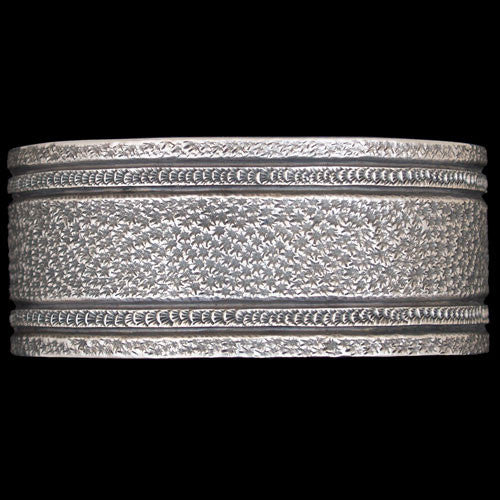
Navajo Sterling Silver Stamped Bracelet - John Begay Jr. (#71)
$600.00
Artist: John Begay Jr.
Navajo Jewelry
Inner Circumference: 6 1/4"
Opening: 1 1/4"
Total: 7 1/2"
Width: 1 1/4"
John Begay Jr. has done it again. This master Navajo silversmith has a knack for coming up with new and unusual designs on a regular basis. Not many artists can accomplish that feat. Many come up with one design and work it to death. Not John! His brain is wired in such a manner that when he comes up with a great idea he naturally leapfrogs’ onto the next. For this reason it is always exciting to see what John will come up with next. This bracelet is completely hand fabricated in just the right weight that will prove comfortable to wear and be durable as well. John Begay Jr. does his best to create excitement around his work and his best is always great.
We offer a 100% satisfaction guarantee on every purchase.

Navajo Sterling Silver Tufa Cast Kingman Turquoise Bracelet - Harrison Jim (#01)
$705.00
Artist: Harrison Jim
Navajo Jewelry
Inner Circumference: 5"
Opening: 1 1/4"
Total: 6 1/4"
Width: 1 3/4"
The art of tufa stone carving and casting can be traced to the early Egyptians. The globetrotting Spanish discovered it there and brought the art form to our American Indians. We are uncertain who taught Harrison Jim, but he darn sure mastered the art. Carving a reverse pattern into volcanic ash is no easy feat; it takes a visionary with steady hands and clear, focused eyes. Harrison is a master craftsman, and he has great taste in turquoise as well. This cab of high-grade natural Kingman turquoise has exceptional color and an appealing matrix. Harrison's combination of top-notch turquoise and exemplary silver work blend beautifully.
We offer a 100% satisfaction guarantee on every purchase.
Related legends:
Silversmith Work
When and how the Navajo acquired the art of working metals is unknown but there are reasons for supposing that it was introduced among them, or at least more developed and improved upon by them, since the time they have occupied their present country?
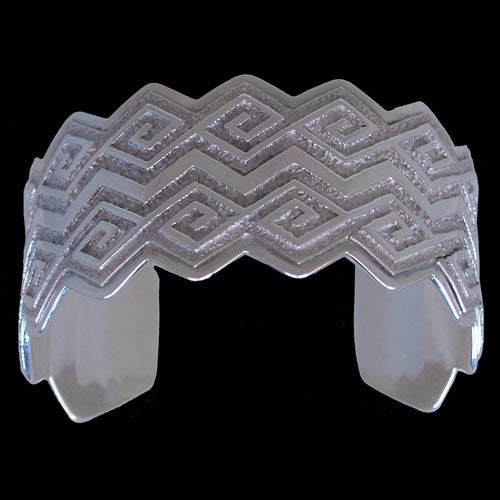
Navajo Sterling Silver Twin Falls Bracelet - Ray Scott (#02)
$1,100.00
Artist: Ray Scott
Navajo Jewelry
Size: 6 1/2
Inner Circumference: 5 1/4"
Opening: 1 1/4"
Navajo artist Ray Scott titled this water inspired bracelet "Twin Falls". This free flowing wrist band is hand fabricated of sterling silver and is reminiscent of the life giving liquid so essential to regeneration and proliferation on this semi-arid landscape. Moisture is a must when you are gifted a mere six inches annually. Ray is inspired by the forces of nature and we benefit greatly from those revealing revelations.
We offer a 100% satisfaction guarantee on every purchase.
Related legends:
Silversmith Work
When and how the Navajo acquired the art of working metals is unknown but there are reasons for supposing that it was introduced among them, or at least more developed and improved upon by them, since the time they have occupied their present country?
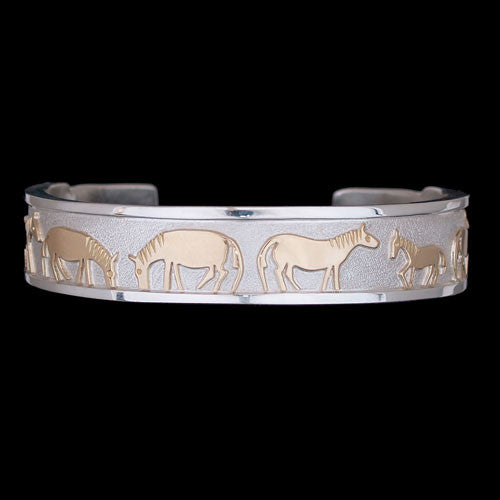
Navajo Sterling Silver w/ 14k Gold Horses Bracelet - Sean Taylor (#01)
$1,495.00
Artist: Sean Taylor
Total inner circumference including opening: 6 1/8"
Opening: 1"
Sean Taylor, the son of Robert Taylor, is extremely fond of horses. So, taking his father’s silversmith style and blending it with a herd of abstract equines, Sean has forged a “wildly” interesting cuff. Sterling silver and 14k gold combine in a pleasing combination. Finish off the design with friendship hands and a spiral for eternity, and you have a terrific bracelet.
Related legends:
Silversmith Work
When and how the Navajo acquired the art of working metals is unknown but there are reasons for supposing that it was introduced among them, or at least more developed and improved upon by them, since the time they have occupied their present country?

Navajo Sterling Silver w/ Sleeping Beauty Turquoise 2 Sided Reversable Pendant - Robert Taylor (#39)
$875.00
Artist: Robert Taylor
Navajo Jewelry
1 7/8" x 1 7/8"
Navajo artist, Robert Taylor, has made a name for himself in the world of Native American Indian art. His attention to detail and extraordinary silversmithing skills place him at the top of his craft. Having been raised on the Navajo reservation, Robert draws inspiration from his early home and family life. As a young boy, Robert, was allowed the opportunity to ride his horse across the wide-open spaces of his homeland. Rug weaving was something his mother and grandmother did on a daily basis. Surrounded by the ceremonial basket motif, Robert proudly shares his heritage through this pendant. The degree of difficulty associated with this work of art is extreme, but Robert handles such things with ease.
We offer a 100% satisfaction guarantee on every purchase.
About the artist:

Robert Taylor - Silver & Goldsmith:
"Cluster, channel, leaf, inlay, casting... I've done about everything," Robert Taylor talks about his silver and goldsmithing, "There's a lot of artists that do it." And then he confides the reason he has set himself apart from other craftsmen. "I didn't really get anywhere until I decided to design my own style."
Related legends:
Silversmith Work
When and how the Navajo acquired the art of working metals is unknown but there are reasons for supposing that it was introduced among them, or at least more developed and improved upon by them, since the time they have occupied their present country?

Navajo Sterling Silver Wing and a Prayer Bracelet - Philbert Begay (#03)
$690.00
Artist: Philbert Begay
Total inner circumference including opening: 6 1/4"
Opening: 1 1/4"
Philbert Begay is a talented young artist who hails from Kayenta, Arizona. Philbert learned the art of silversmith work from his father, Richard Begay, who has an elevated reputation for quality workmanship in his own right. This bracelet depicts a young, attractive Navajo maiden communing with flora and fauna of the natural world. The Navajo people are recognized for having close bonds with nature, and Philbert expresses that sentiment oh so well.
About the artist:

Related legends:
Silversmith Work
When and how the Navajo acquired the art of working metals is unknown but there are reasons for supposing that it was introduced among them, or at least more developed and improved upon by them, since the time they have occupied their present country?

Navajo Sterling Silver Yei Pendant - Robert Taylor (#36)
$625.00
Artist: Robert Taylor
Navajo Jewelry
1" x 3 1/2"
Corn Yeis are significant to the Navajo because they represent creation, fruition, multiplication and upward movement. Robert Taylor, a real character and master silversmith, has created a gracefully flowingly, sterling silver pendent using the imagery of this genuinely significant deity. Because "The People" believe they were created from corn, it is often represented in their art. Robert has a passion for his culture and his art, which is why both are so well presented in this piece.
We offer a 100% satisfaction guarantee on every purchase.
About the artist:

Robert Taylor - Silver & Goldsmith:
"Cluster, channel, leaf, inlay, casting... I've done about everything," Robert Taylor talks about his silver and goldsmithing, "There's a lot of artists that do it." And then he confides the reason he has set himself apart from other craftsmen. "I didn't really get anywhere until I decided to design my own style."
Related legends:
Silversmith Work
When and how the Navajo acquired the art of working metals is unknown but there are reasons for supposing that it was introduced among them, or at least more developed and improved upon by them, since the time they have occupied their present country?

Navajo Storm Pattern Rug - Gabriel Benally (#14)
$2,495.00
Artist: Gabriel Benally
47" x 82"
Storm pattern weavings always capture us; we love the symbolism and the graphics. Of course the fact that it is one of the most recognizable styles of Navajo weaving doesn’t hurt. Gabriel Benally has been weaving this type for most of his career and knows exactly how to energize his rugs. His weavings are electric, energizing.
About the artist:

Related legends:
Storm Rugs
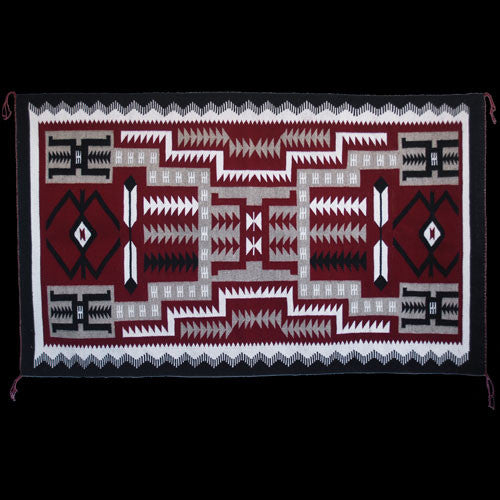
Navajo Storm Pattern Weaving - Marie Sheppard (#03)
$1,650.00
Artist: Marie Sheppard
48" x 29"
The storm design is one of the most recognized patterns in Navajo rug weaving. It is impressive because it depicts the emergence of a people, their sources of protection, life signs and, most exciting, thunder and lightning. Marie Sheppard weaves one of the most refined storm pattern rugs anywhere. Her weave is smooth, even, tight and her pattern wholly symmetrical. No wonder people get excited about her rugs.
About the artist:
 Sitting on the floor in front of her loom up to fourteen hours a day, Marie Burbank Sheppard may weave only six to eight inches on a three foot wide rug in that much time. This intense effort is a labor of love for her as she works the wool yarn she has dyed herself. Raised outline rugs are her trademark, created by using a double weave. Her technical style of design has incorporated up to 44 colors in one rug, usually subtle colors as she loves earth's pastels. This grandmother has won multiple awards at the Gallup Ceremonials and is considered by many experts to be a top weaver. See full biography
Sitting on the floor in front of her loom up to fourteen hours a day, Marie Burbank Sheppard may weave only six to eight inches on a three foot wide rug in that much time. This intense effort is a labor of love for her as she works the wool yarn she has dyed herself. Raised outline rugs are her trademark, created by using a double weave. Her technical style of design has incorporated up to 44 colors in one rug, usually subtle colors as she loves earth's pastels. This grandmother has won multiple awards at the Gallup Ceremonials and is considered by many experts to be a top weaver. See full biography
Related legends:
Storm Rugs

Navajo Teec Nos Pos Weaving - Evelyn Poyer (#01)
$800.00
Artist: Evelyn Poyer
Evelyn Poyer wove this very attractive Navajo rug. This regional style owes much to the influence of Persian rug designs and the input of early Crystal, New Mexico trader John B. Moore. This Teec Nos Pos rug is tightly woven from plied yarns in colors that range from bright jewel tones to earth tones and even pastels. It has a distinctive broad border with an "X" shape and an elaborate center with smaller complementary design elements.
Related legends:
Weaving
After the medicine woman told the people about the prayersticks she told them that there was a place in the underworld where two rivers crossed. It was called ni tqin'kae tsosi, fine fiber cotton (Indian hemp). There were two persons who brought the seed of that plant, they were spiders. They said that the people were to use the plant instead of skins for their clothing. So this seed was planted in the earth? More about this legend
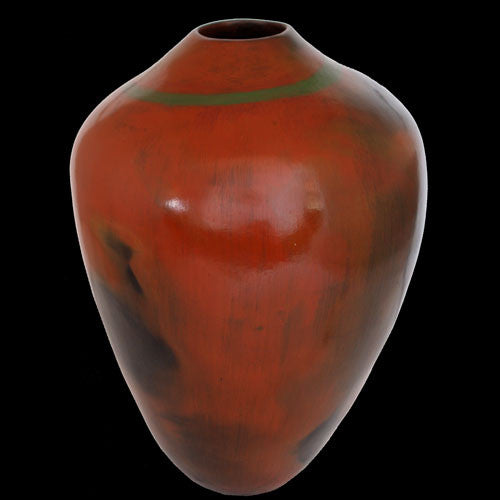
Navajo Thin Green Line Coiled Pottery Vase - Alice Cling (#08)
$975.00
Artist: Alice Cling
Circumference: 26"
Height: 11 1/4"
Opening: 2"
Navajo artist Alice Cling was born in a hogan near Cow Springs, Arizona, 60 years ago. This hand coiled and burnished vessel is also embellished with a thin coat of Pinion pitch. Its enduring beauty comes from Alice's unusual use of colored clay slips and from the striking variations of natural colors caused by outdoor firing. Very few Navajo potters approach the high quality of creativity Alice Cling achieves with her art.
About the artist:

Related legends:
Pottery
The Navajo are relatively recent arrivals to the Southwest. They probably migrated from the north in the 16th Century thereby becoming a part of the Pueblo IV period. The Navajo have made pottery since their arrival; possibly they brought pottery with them during their southern migration. They made a plain and decorated pottery. The plain being considered the older style? More about this legend

Navajo Three Necklaces Basket - Elsie Holiday (#376)
$3,125.00
Artist: Elsie Holiday
Navajo Basket
16" x 18" x 1" deep
Rounds: 24
Elsie Holiday has taken a rainbow of colors to make this figurative basket. Faces have become her forte, and we must face it, she is the best. When it comes to execution, there is none better.
We offer a 100% satisfaction guarantee on every purchase.
About the artist:

Considered one of the best Navajo basket weavers, Elsie Stone Holiday married into the famed Douglas Mesa family of weavers. Weaving baskets has become almost an addiction for her. "When I go two or three days without weaving I get anxious to get started again," she says. She weaves 12 hours a day, 5 days a week. "Sometimes I think, 'How long can this last?'", she wistfully states, but for now she is content with her art, finding immense satisfaction in creating premier quality baskets.
Related legends:
Navajo Changing Woman
These four visit Changing Woman in her home in the west and see how she changes her age and form as she passes through doors at each of the directions. She decrees her gifts to earth people Cloud, rain, pollen, dew and gives them prayersticks. She tells them that now "there is no meanness left" in her : however First Man and Woman who went east are mean, and from them will come epidemics, colds, and coughs to be cured by offerings of white corn?
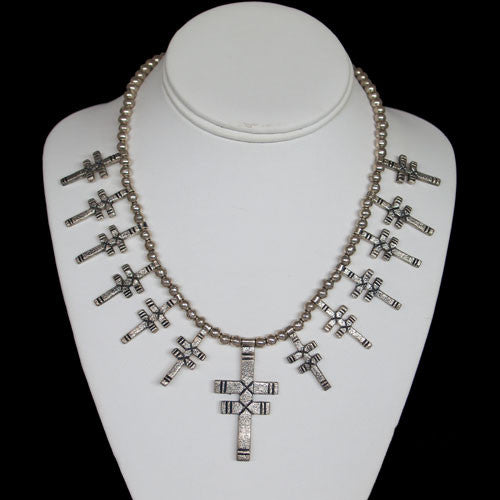
Navajo Tufa Cast Dragonfly Cross Necklace - Harrison Jim (#06)
$1,140.00
Artist: Harrison Jim
17 1/4" long
Spanish artisans first introduced the Navajo people to silversmith work and the pattern of the cross. Since that time the cross has been one of the most recreated designs in Navajo art. Harrison Jim mastered the art of casting designs in tufa stone years ago and does it very well. By using the widely accepted symbol of the double cross, Harrison has created a necklace to honor tradition and culture that spans the ages.
Related legends:
Silversmith Work
When and how the Navajo acquired the art of working metals is unknown but there are reasons for supposing that it was introduced among them, or at least more developed and improved upon by them, since the time they have occupied their present country?

Navajo Tufa Cast Sterling Silver Coral Cuff Bracelet - Harrison Jim (#03)
$360.00
Artist: Harrison Jim
Navajo Jewelry
Inner Circumference: 5"
Opening: 1 1/8"
Total: 6 1/8"
Tufa casting is an art not many have developed. Harrison Jim, however, has learned well. This water design cuff is cast to last and sports a super piece of Mediteranian coral that will make a Sicilian envious. Sea what we mean.
We offer a 100% satisfaction guarantee on every purchase.
Related legends:
Silversmith Work
When and how the Navajo acquired the art of working metals is unknown but there are reasons for supposing that it was introduced among them, or at least more developed and improved upon by them, since the time they have occupied their present country?

Navajo Tufa Cast w/ Mediteranean Coral Bracelet - Harrison Jim (#02)
$930.00
Artist: Harrison Jim
Navajo Jewelry
Inner Circumference: 5 3/4"
Opening: 1"
Total: 6 3/4"
Harrison Jim is a silversmith who seems to have been born to the art. We know he was raised in Gallup, NM, which is the capital of silversmith art. His mother and grandmother were both high-quality rug weavers, which is where Harrison learned about technical detail. One of the many nice things about Harrison's work is that he is not afraid to use plenty of silver and super nice stones. This sandcast bracelet is substantial, and the coral cabochon is top notch. This bracelet is a classic example of a top-quality Navajo silversmith.
We offer a 100% satisfaction guarantee on every purchase.
Related legends:
Silversmith Work
When and how the Navajo acquired the art of working metals is unknown but there are reasons for supposing that it was introduced among them, or at least more developed and improved upon by them, since the time they have occupied their present country?

Navajo Turquoise Yei Rug - Kathryn Begay (#03)
$1,100.00
Artist: Kathryn Begay
40" x 26"
Finely woven and carefully crafted, that is what Kathryn Begay was aiming for in her latest Yei weaving. Since Yeis are so important culturally, Kathryn has taken her time to represent them especially well and in the process has made a rug of beauty.
Related legends:
Yei
Every creature, every aspect of nature has its holy people . . . . even the stinkbug. Sometimes you can see them, if only for an instant. They are represented, some of them, by colors: the blue sky, the evening dusk, the night these are holy people and one prays to them. There are iron people, crystal people, then the other rocks "and such people." There are dawn people, twilight people, air, thunder, and cloud people. One does not talk about such things in nature when they and their holy people are present.

Navajo Two Grey Hills Rug (#53)
$1,600.00
49 1/2" x 34 3/4"
This very nice Two Grey Hills rug was woven approximately in the 1970’s. Its warm earth tones are why it is described as such. It’s a fine example of the soft colors and tight weaving associated with such Navajo rugs. We do not know the weaver because the original buyers collection, of which it came from did not keep track of the name. But the artist surely must have been accomplished.
Related legends:
Two Grey Hills Rugs

Navajo Two Grey Hills Rug - Calvin Toney (#01)
$6,300.00
Artist: Calvin Toney
68" x 88"
Years ago we bought rugs from Navajo master weaver Beth Bitsuie. After a time we began purchasing from her daughter and daughter-in-law, who had been carefully trained by Beth. Now we have begun to buy the weavings of Beth's grandson, Calvin Toney. All these weavers have developed a steady hand and careful eye for weaving. This large Two Grey Hills rug by Calvin is exceptional for its fine craftsmanship and exquisite design.
Related legends:
Two Grey Hills Rugs

Navajo Two Grey Hills Rug - Larry Nathaniel (#01)
$1,500.00
Artist: Larry Nathaniel
Navajo Rugs
24" x 32"
Larry Nathaniel weaves outstanding “Two Grey Hills” rugs. This rug is finely woven, extremely symmetrical and the pattern stands-out by way of a crisp, clean design. Earth tone color schemes are Larry's specialty; no dyes are used and no sheep abused. Larry is from the Four Corners area of the Navajo Reservation and is considered one of the best weavers from the "Canyon Country".
We offer a 100% satisfaction guarantee on every purchase.
Related legends:
Two Grey Hills Rugs

Navajo Two Grey Hills Rug - Phyllis James (#02)
$1,350.00
Artist: Phyllis James
37" x 26 1/2"
Phyllis James has woven this most excellent example of the Two Grey Hills style of Navajo textiles. Two Grey Hills is located to the east of the Chuska Mountains and south of Shiprock, New Mexico. Navajo rugs from this area feature intricate designs woven with natural sheep wool in varying hues of brown, cream and grey, anchored with black and white. The black is typically over-dyed to make a more solid contrast with the other colors. Two Grey Hill rugs will typically have a single or double serrated design as the central focus within the weaving. Other design elements such as geometrics, stair steps, even occasionally, pictorial elements will take up the balance of the weaving. A dark border typically surrounds the interior design elements. As mentioned, this one is superb.
About the artist:

Related legends:
Two Grey Hills Rugs
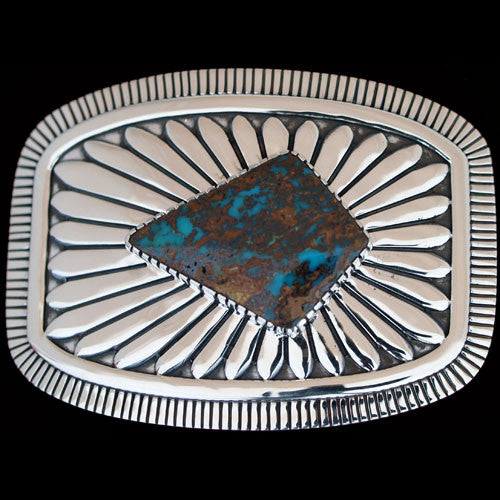
Navajo Tyrone Turquoise Buckle - Allison Lee (#163)
$2,400.00
Artist: Allison Lee
ATC
Navajo Jewelry
3" x 2"
Oh, Allison Lee the silversmith, who never, never, never disappoints. His work is so classically clean it makes you weep. Using a 24.3 carat piece of Tyrone turquoise and his hallmark stamping, Allison has hammered out a buckle that would make anyone shine.
We offer a 100% satisfaction guarantee on every purchase.
Tyrone Turquoise
The Tyrone turquoise mining district is made up of a small cluster of mines in the Burro Mountains near Silver City, New Mexico. This group of mines is associated with the Tyrone Copper mine owned by Phelps-Dodge. Many turquoise historians believe that more high-grade, natural turquoise was produced in this area than any single American turquoise deposit on record. Turquoise mining in the Burro Mountains has been traced back to prehistoric times. Spanish colonists mined the workings in their own time. Mining artifacts such as stone and metal tools along with fragments of turquoise mined in this fashion were common at the sites.
An early mining engineer, named Zalenski, who visiting the mines in 1907, witnessed traces the "fire-fracture" process of extracting turquoise from the host rock. Zalenski also documented one forty-foot shaft though most of the workings. The main mining process was by way of following a vein through open trenching. Early miners and archivists mention ancient and historical Indian burial grounds in the area. The graves, most often, contained offerings of turquoise. These early excavations helped to determine the locations of some of the more modern claims. According to Pogue, John Coleman aka; "Turquois John" is credited with discovering the first modern mine in the area. While on a hunting trip in 1875, John, along with W.J. Foley and Nicholas Ransome of Silver City, are credited with discovering old excavations. The men were following up on a tip from local Indian traders. Turquoise was presumed present near the town and ancient workings were known to exist in the mountains. Their search of the Burro Mountains and surrounding area proved the rumors to be true.
The largest and most recognized mine of the Tyrone workings was the Azure. The Azure mine was initiated in 1891 and was located 10 miles southwest of Silver City. Pogue states in his 1915 classic; Turquoise, Memoirs of the National Academy of Sciences, wrote; "It has been operated in modern times more extensively than any other turquois mine in this country, and its stones are the equal of the Persian gems.” In 1893 the “Elizabeth Pocket” was discovered, which produced more high-grade turquoise than any single deposit on record. The Elizabeth Pocket was 100 feet long, 40 feet wide, and 40 to 50 feet deep. At the time it was believed to be the riches vein of turquoise ever discovered. Cabochons produced from this mine were marketed throughout the country with ads appearing in Harper and McClure’s magazines. Each gem was engraved with a circle on the back with the ad stating, "None genuine without the ring O on the reverse side.” Because of its extremely hard and durable nature Azure turquoise was guaranteed not to change color. Tyrone turquoise available on today's market is mostly from older collections. In its high-grade form Tyrone turquoise is a hard, translucent, brilliant or deep blue and is highly valued by collectors for it beauty and rarity.
About the artist:

Allison Lee - Navajo Silversmith:
Speaking of the silver and gold jewelry he hand crafts, Allison Lee's captivating voice is sincere when he says, "One time my uncle told me that everything we build comes from the earth, like the silver that comes from the earth, or the turquoise that comes from the earth. That is a lot of energy. You put it together and you put your heart and mind into a piece. Then sometimes a certain piece of jewelry- I believe- it is made for a certain person. I usually have a ring, or something, that stays with me for about two or three years, until the right person comes along. And then that person buys that piece. I believe that every piece of jewelry that I make is made for somebody out there- it's made for somebody special. Whoever might be having problems, or something like that. In essence, that energy helps that person get help, by wearing pieces that we make. That is the way I look at it.
Related legends:
Precious Stones
Turquoise; Precious stones have symbolic implications. For example, turquoise if a "collective term for all the precious stones, wealth, or mixed offerings. Good fortune is attributed to this stone." Both white shell and turquoise are emphasized in Kinaalda? More about this legend
Silversmith Work
When and how the Navajo acquired the art of working metals is unknown but there are reasons for supposing that it was introduced among them, or at least more developed and improved upon by them, since the time they have occupied their present country?
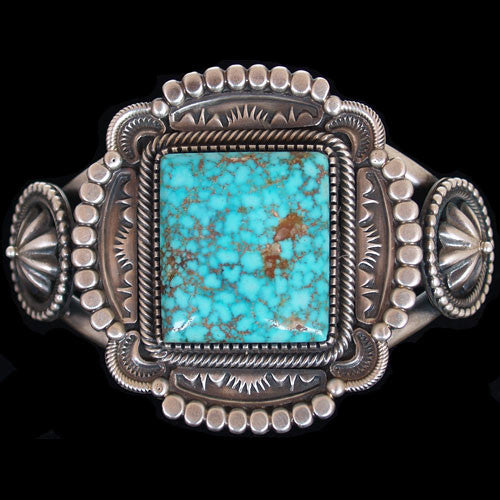
Navajo Waterweb Kingman Turquoise Bracelet - Ray Bennett (#01)
$1,250.00
Artist: Ray Bennett
Navajo Jewelry
Inner Circumference: 5 1/4"
Opening: 1"
Total: 6 1/4"
Width: 2" x 1 3/4"
You can almost hear the “snap” when an artist matches a great stone with crisp silver work. In this particular bracelet, Navajo silversmith Ray Bennett has located a super piece of Water web Kingman turquoise and then built an amazing setting to showcase the stone. Maybe it should be “snap, crackle, pop”.
We offer a 100% satisfaction guarantee on every purchase.
Kingman Turquoise
Kingman Turquoise comes from a large open-pit copper mine in the Mineral Park Mining District, northwest of Kingman, Arizona and was one of the largest turquoise mines in this country. The area lies in high desert country at an elevation of 3,345 feet and is surrounded by three mountain ranges. The mining district around Kingman, Arizona has always been a large producer of turquoise, at one time the world's largest. First mined by Indians, this area was home to the most extensive prehistoric workings found in Arizona.
The modern production of turquoise dates back to the early 1880πs when James Haas rediscovered these ancient Kingman area mines. Much of the turquoise occurred as seams, masses and veins. The color of natural Kingman turquoise can range from light blue to very dark blue and sometimes tints of green. The matrix is from white, light brown to black and frequently flecked with pyrite and times quartz. The mine became famous for its rounded, bright blue nuggets with black matrix. Few turquoise mines produced nuggets, especially of this quality. In its high-grade form it has always been considered among the top quality American turquoise. With so many thousands of pounds of good quality turquoise produced in the Kingman area over the last one hundred years it is hard to believe that today very little high-grade Kingman turquoise is available.
Other names for Kingman turquoise: Ithaca Peak, The Wall, Tiffany, Courtland, Az., Gleeson
Most desirable: Deep Blue with molybdenum pyrite; Real blue with pyrite; Bird's eye; Water Web; Nuggets
Related legends:
Precious Stones
Turquoise; Precious stones have symbolic implications. For example, turquoise if a "collective term for all the precious stones, wealth, or mixed offerings. Good fortune is attributed to this stone." Both white shell and turquoise are emphasized in Kinaalda? More about this legend

Navajo Whirlwind Polychrome Basket - Elsie Holiday (#399)
$4,500.00
Artist: Elsie Holiday
Navajo Basket
18" x 6" deep
Rounds: 32
This basket design originated from a photograph of Yellow Feather, a Maricopa Indian woman. The original image was likely taken in the late 1800s, and featured Yellow Feather posing with a wonderful weaving perched on her head. When Elsie Holiday saw the photo, she knew she would recreate the basket. In her precise style, Elsie has done exactly that and once again created wonderment. You can never go wrong acquiring an Elsie Holiday basket.
We offer a 100% satisfaction guarantee on every purchase.
About the artist:

Considered one of the best Navajo basket weavers, Elsie Stone Holiday married into the famed Douglas Mesa family of weavers. Weaving baskets has become almost an addiction for her. "When I go two or three days without weaving I get anxious to get started again," she says. She weaves 12 hours a day, 5 days a week. "Sometimes I think, 'How long can this last?'", she wistfully states, but for now she is content with her art, finding immense satisfaction in creating premier quality baskets.
Related legends:
Whirlwinds/Breathing
After the bow and arrows of lightning were returned to the Sun, Hasjelti and Hasjohon came to First Man and First Woman and asked them what they thought about all that had happened. "What will take place now will be your plan," they said. "Yes," answered First Man and First Woman, "Now it must be our plan. We will think about it." The Sun brought a turquoise man fetish and gave it to Yol gai esdzan, the White Bead Woman? More about this legend
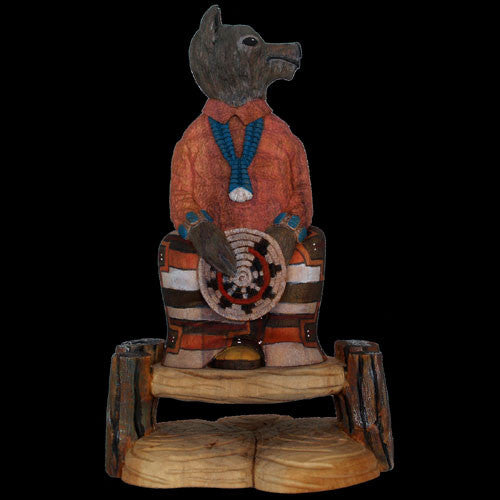
Navajo Wolf Basket Cottonwood Root Carving - Marvin Jim (#376)
$625.00
Artist: Marvin Jim
Base: 7 1/4" x 6 3/4"
Height: 12"
Marvin Jim is an accomplished woodcarver. Surely that's why his depiction of the Wolf Chief captures the myths and legends surrounding this wondrous creature. Sitting upon a rock dais, the Wolf Chief rules over all creatures that fly, crawl, run or swim. That has to be a huge job, but this lobo seems to have his work well under control. Because of its fibrous nature, and since it is both soft and durable, Marvin carves with cottonwood root, which is the traditional material for Navajo sculptures. May this old boy reign forever, and may Marvin continue to carve for a long time.
About the artist:

Marvin Jim - Animal Sculptures:
Based upon the Navajo creation tales, the sculptures of Marvin Jim reflect a time long ago, when animals and humans walked and worked together to create a new world. These traditional stories speak of conversations among all beings, of behaving in a manner of mutual respect and of all beings having an equal position in the community. These legends are an essential part of the Navajo culture. The tales are of universal interaction, compassion and tolerance; the things necessary to live a balanced existence.
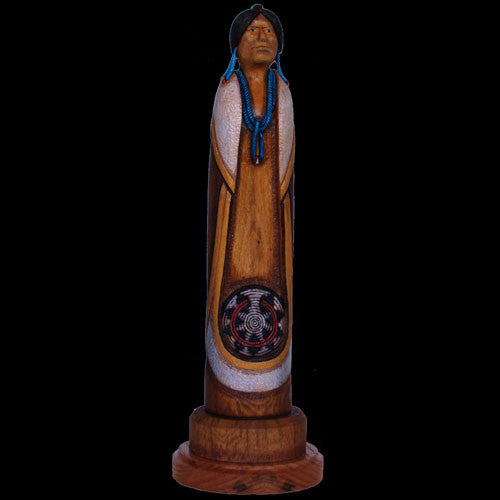
Navajo Woman Folkart Carving - Cecil Miles (#02)
$495.00
Artist: Cecil Miles
Folk Art
4 1/4" x 13 1/4"
Navajo artist Cecil Miles has captured the essence of the Basket Dance with this cottonwood root sculpture. The basket dance is a spin-off of the Mountain Chant and involved young Navajo women dancing to portray the importance of the traditional basket to Navajo ceremonialism and culture. Ceremonial baskets represent the essence of the initiation of life; how to approach life in an effective, productive manner; and how to discover harmony and balance therein. Yes, all that is in Cecil's sculpture. Amazing, isn't it.
We offer a 100% satisfaction guarantee on every purchase.
About the artist:

Related legends:
Women/Taboos
It is understandable that the superficial white observer concludes that the Navaho woman is little better than a chattel of her husband. She may be seen walking when her husband is on horseback; the casual white visitor does not realize that the reverse is also true, depending on which of them has a horse available, for horses are individually owned and there is no conception of joint property between husband and wife? More about this legend

Navajo XL Two Grey Hills Rug (#52)
$7,950.00
9' 1 1/2" x 5' 6"
This is a really majestic, old style Two Grey Hills weaving circa 1920's or 30's. Because of its age, we do not know the weaver but we do know she was a master artist. The rug is made completely of hand-shorn wool and is hand carded and spun as well. The colors are completely natural except for the red, aniline dyed edge cords. This is a heavy well-made weaving that has seen very little wear and shows no damage from ultraviolet light. This weaving is a classic example of a big, bold, beautiful Navajo textile.
Related legends:
Two Grey Hills Rugs

Navajo Yei Weaving - Luana Tso (#53)
$3,500.00
Artist: Luana Tso
Navajo Rug
39" x 60"
Luana Tso weaves representations of the Navajo Holy People on a grand scale. Many years ago Luana began making rugs featuring these supernatural beings in a large format, and has since become well known for her intricate depictions these mythological figures. Luana will turn 60 this year and has built quite a career weaving unusual and uniquely pleasing pieces such as this. Let's wish her happy birthday, and send a message to the gods asking that she be allowed to continue making her wonderful weavings.
We offer a 100% satisfaction guarantee on every purchase.
About the artist:
 Luana Tso has had a dream for many years now, and it is woven into each one of her Navajo rugs. She has three sons, and for each she dreams of a college education. This bright hope for her children's future keeps her at her loom from eight to fourteen hours a day, weaving traditional patterns, all the while trusting that her efforts will develop a new tradition for her family: higher education. See full biography
Luana Tso has had a dream for many years now, and it is woven into each one of her Navajo rugs. She has three sons, and for each she dreams of a college education. This bright hope for her children's future keeps her at her loom from eight to fourteen hours a day, weaving traditional patterns, all the while trusting that her efforts will develop a new tradition for her family: higher education. See full biography
Related legends:
Yei
Every creature, every aspect of nature has its holy people . . . . even the stinkbug. Sometimes you can see them, if only for an instant. They are represented, some of them, by colors: the blue sky, the evening dusk, the night these are holy people and one prays to them. There are iron people, crystal people, then the other rocks "and such people." There are dawn people, twilight people, air, thunder, and cloud people. One does not talk about such things in nature when they and their holy people are present.

Navajo Yei-be-Chei Dancer Rug - Anna Gray (#02)
$750.00
Artist: Anna Gray
Navajo Rug
35" x 24 1/2"
Yei rugs are the most symbolic rugs in the Navajo weaving tradition. The Yeis they portray are the deities the Natives worship and hold sacred. Speaking to the healing arts and the gods who assist in the rite, Anna Grey tells of the power of these beings and the beauty of Navajo rugs.
We offer a 100% satisfaction guarantee on every purchase.
Related legends:
Yei
Every creature, every aspect of nature has its holy people . . . . even the stinkbug. Sometimes you can see them, if only for an instant. They are represented, some of them, by colors: the blue sky, the evening dusk, the night these are holy people and one prays to them. There are iron people, crystal people, then the other rocks "and such people." There are dawn people, twilight people, air, thunder, and cloud people. One does not talk about such things in nature when they and their holy people are present.
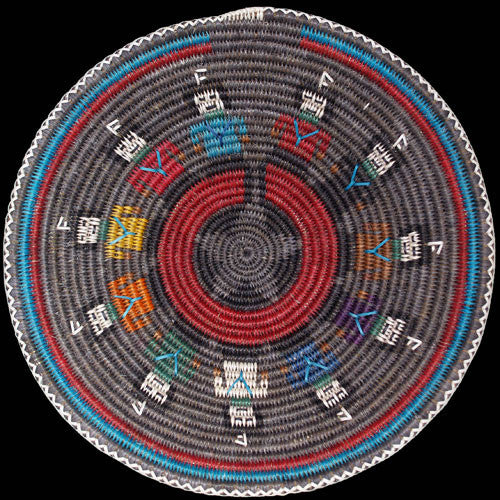
Navajo Yei-be-chei Dancers Basket - Peggy Rock Black (#387)
$1,750.00
Artist: Peggy Rock Black
Navajo Baskets
17" x 2 3/4" deep
Rounds: 28
Peggy Rock Black has woven a basket portraying beings put upon this earth to counter sickness and disease. A gift of Talking God, the Yei-be-chei are called into action by medicine men familiar with the required ceremonies and songs. Patients ailing in mind or body can be brought back into harmony by these powerful practitioners. Peggy has placed a rainbow around her helpful healers to protect them from evil and negativity. The world is a better place due to the gift of Talking God and the homage paid to the big guy by the likes of Peggy Rock Black.
We offer a 100% satisfaction guarantee on every purchase.
About the artist:

One of the famous Douglas Mesa basket weavers, there wasn't much question about what Peggy Rock Black would choose to pursue in life. She was born into a family of weavers before she married into an equally talented family of weavers.
Related legends:
Ritual Ceremony
Various kinds of clay are used by the Navaho ceremonially and otherwise. Dlesh, white clay, is used as spice with foods, or in painting the masks. The fire dancers paint their bodies with it on the night of the performance? More about this legend

Navajo Yei-be-chei Weaving - Treva Peshlakai (#02)
$900.00
Artist: Treva Peshlakai
42 1/2" x 26"
Yei-be-chei rugs such as this are intended to represent healing and ancient ways that ensure a happy, healthy life. Treva Peshlakai has done a fine job representing these spiritual beings engaged in making their patient feel better. Get this one for your home and start living the good life.
Related legends:
Weaving
After the medicine woman told the people about the prayersticks she told them that there was a place in the underworld where two rivers crossed. It was called ni tqin'kae tsosi, fine fiber cotton (Indian hemp). There were two persons who brought the seed of that plant, they were spiders. They said that the people were to use the plant instead of skins for their clothing. So this seed was planted in the earth? More about this legend
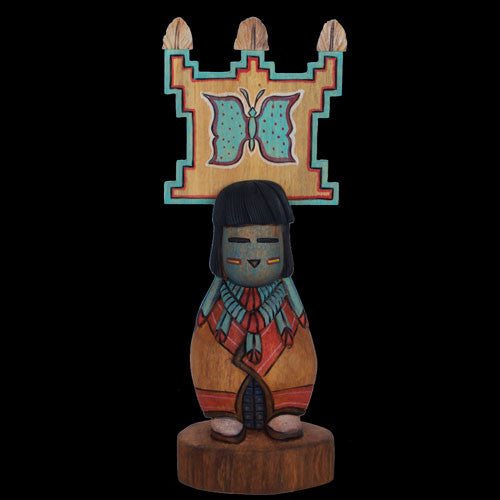
Navajo/Hopi Blue Corn Butterfly Maiden Carving - Dennis Ross (#73)
$315.00
Artist: Dennis Ross
3 3/4" x 3" Height: 10 1/2"
Dennis Ross, Navajo/Hopi artist, has the hands of a lumberjack and the carving ability of a sculptor. Because of his dual heritage Dennis often blends design and motif to craft his imaginative art forms. In this case Dennis has produced a sculpture that portrays a Hopi Butterfly Maiden that is believed to govern the spring and a Navajo Corn Spirit that allows growth of the most precious of food source. The combination of characters allows for a most attractive and appealing figure.
About the artist:
 Asked how he first started carving, Dennis Ross answers with a laugh, "My brother - he gave me a knife, and a stone, and a piece of carving wood, and said, 'Here you go'." Dennis was twenty-six years old. His brother, Harry Bert, also gave him a little constructive criticism on that first experiment into the creative world of carving, but Dennis took it from there.
Asked how he first started carving, Dennis Ross answers with a laugh, "My brother - he gave me a knife, and a stone, and a piece of carving wood, and said, 'Here you go'." Dennis was twenty-six years old. His brother, Harry Bert, also gave him a little constructive criticism on that first experiment into the creative world of carving, but Dennis took it from there.
Related legends:
Corn Spirits in Navajo Mythology
Then it was that they moved upward, leaving the dark world behind. They climbed on top of the Four Mountains, which grew upward with them, and they all moved up onto a lighter world. The Wind People brought seeds into the new world, and they planted them:?

Navajo/Hopi Sterling Silver Parrot Symbol Pendant (#53)
$290.00
This pendant came to us through and estate and we were more than happy to see it. We have been arguing its origin for some time now and have narrowed our hypothesis to Hopi, with a Navajo twist. The design work is Hopi with the parrot and kiva step design, but the texture seems more Navajo. At any rate, the pendent is extremely attractive and has no trouble standing out in either cultural arena.
Related legends:
Silversmith Work
When and how the Navajo acquired the art of working metals is unknown but there are reasons for supposing that it was introduced among them, or at least more developed and improved upon by them, since the time they have occupied their present country?
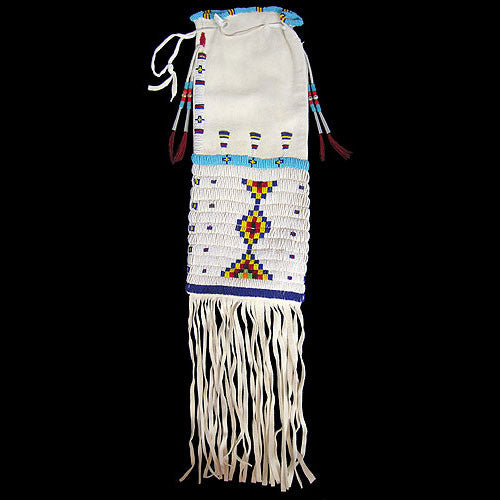
Northern Cheyenne Tobacco or Pipe Bag - Margaret Sooktis
$1,750.00
Artist: Margaret Sooktis
Plains Beadwork
Tobacco or Pipe Bag
Brain-tanned leather, glass
beads, metal cones & dyed
horse hair
6 1/8" wide x 15 3/4" long
(24 1/2" long with fringe)
Northern Cheyenne
We offer a 100% satisfaction guarantee on every purchase.
Margaret Sooktis passed away in 1997. She was one of the great contemporary Northern Cheyenne bead artists.
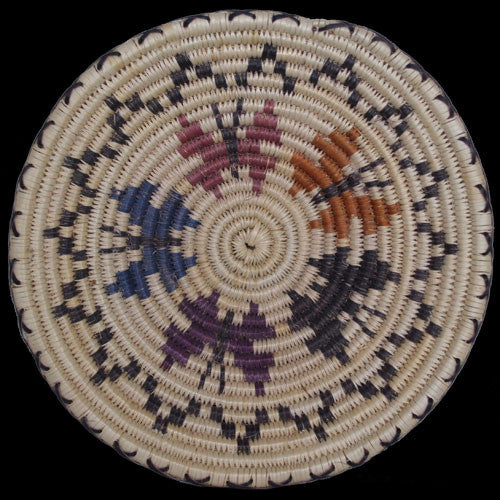
Paiute Butterfly Basket - Grace Lehi (#01)
$600.00
Artist: Grace Lehi
7 1/8" x 3/4" deep
Rounds: 18
Here in Canyon Country we don't often see baskets from the San Juan Paiute. The reason is that Navajo Mountain is a fur piece from Bluff, and the trip can be difficult to navigate. This basket actually made its way across the Colorado River drainage twenty some odd years ago. Back then we purchased it from Grace Lehi and promptly put it away. It is now time to bring it back into the light and share it with others who have the same interest.
Related legends:
Navajo Basketry
Basketry is a woman's industry, which is also pursued by the nadle (he changes), hermaphrodites, or men skilled in the arts and industries of both men and women. Basketry, however, is not classified with textile fabrics (yistl'o), but with sewing (nalkhad). It is of interest also that, while the basket is in progress, the sewer is untouched and avoided by the members of her family?
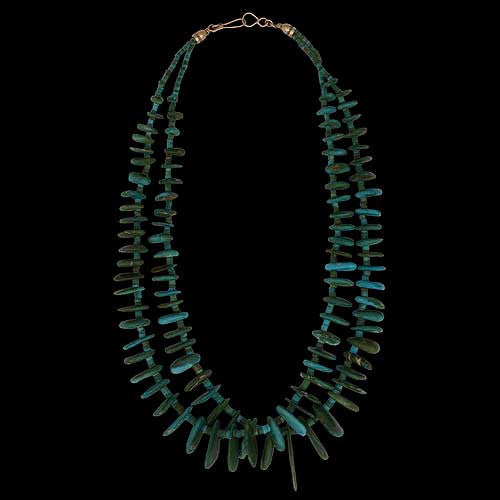
Persian Turquoise Necklace w/ 14 Karat Gold Clasps - John Huntress (#8)
$5,250.00
Artist: John Huntress
Persian/Armenian Turquoise:
In the Southwest, we tend to take turquoise for granted, yet it has been labeled the “Gemstone of the Centuries”. Over 7,500 years ago, slave convoys were sent into the Sinai Peninsula to pluck pieces of the blue gem from the rocks where it had formed. In ancient Egypt, turquoise was believed to have mystical powers and appeared in amulets and talisman representing their gods Amum and Isis. A gold and carved turquoise bracelet was found on the mummified arm of Queen Zer, a ruler during the first dynasty of Egyptian pharaohs. The four bracelets found in her burial are the earliest known examples of precious metal jewelry.
The Middle East emerged as the great purveyor of turquoise, supplying the ancient Egyptians, Nubians, Greeks and Romans. It is believed the name was derived from the French word, Turquie, a reference to the Turkish traders first bringing the rich blue stones to the European continent. It was assumed that the brilliant blue and green stones originated in Turkey when, in fact, they were most likely extracted from mines in the Sinai Peninsula and the Alimersai Mountain in Persia (Iran).
About the artist:

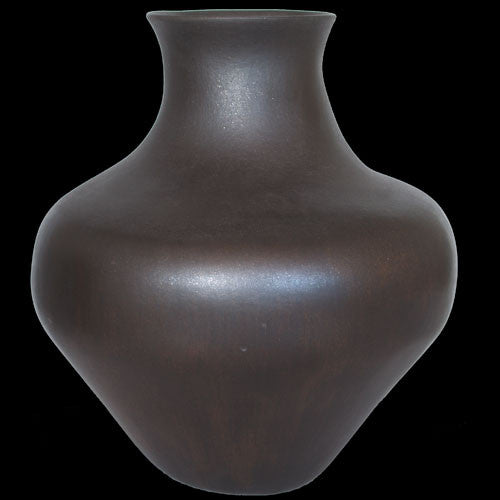
Santa Clara/Taos Micaceous Clay Reduction Fired Pottery Vase - Edna Romero (#01)
$2,800.00
Artist: Edna Romero
Circumference: 36 3/4"
Height: 13"
Opening: 4 1/2"
In the world of Native American art, Edna Romero is related to the best potters in the business. There is so much talent surrounding her that she had no choice but to become a potter. And become a potter she did—a most masterful potter. Edna now lives in Taos but her roots are in the New Mexico pueblo of Santa Clara. The classic beauty of this micaceous pottery vessel is due to its amazing symmetry and fine finish. This vessel is of the quality that makes her royal family proud.
About the artist:

Related legends:
Pottery
The Navajo are relatively recent arrivals to the Southwest. They probably migrated from the north in the 16th Century thereby becoming a part of the Pueblo IV period. The Navajo have made pottery since their arrival; possibly they brought pottery with them during their southern migration. They made a plain and decorated pottery. The plain being considered the older style? More about this legend
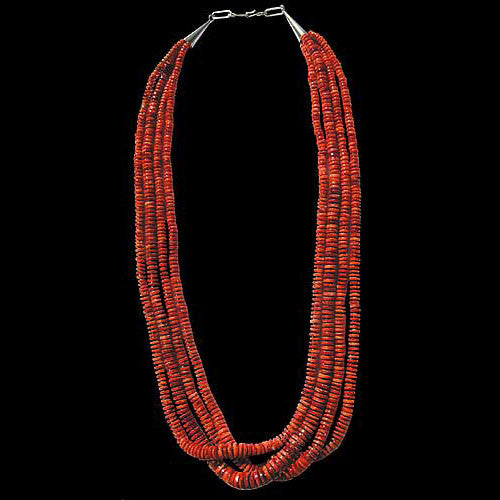
Santo Domingo 4 Strand Spiny Oyster Bead Necklace - Ken & Angie Aguilar (#01)
$1,500.00
Artist: Ken & Angie Aguilar
Southwest Jewelry
31" long
Kenneth and Angie Aguilar are well-known Santo Domingo bead makers, and this orange spiny oyster necklace illustrates their talents. The beads in this necklace are hand formed on a sanding wheel one by one. So I’m sure you can appreciate the time it took to make all 4 strands. The colors of orange and orange-cream are deep and rich. The clasps are made of sterling silver. Mmm-m, this one is tangerine sweet.
We offer a 100% satisfaction guarantee on every purchase.
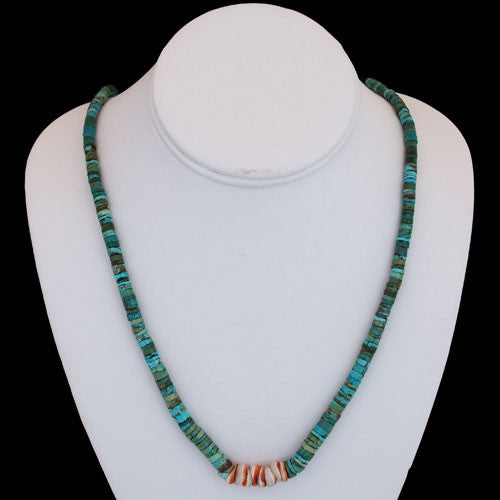
Santo Domingo Handmade Cripple Creek Turquoise Bead Necklace - Joe Reano Sr. (#02)
$4,500.00
Artist: Joe Reano Sr.
Southwest Jewelry
29" long
Our dear old Daddy (Grandpa Duke) discovered this necklace in a slightly different form. Let us explain: While touring the Tucson Gem and Mineral Show, Dad met a lady from the east coast attempting to disperse her long held collection of southwest jewelry. It seems this woman had exquisite taste, so Duke struck a deal. Within that collection were three sets of matching Santa Domingo Jacla earrings. When we shared the find with Ray Lovato he claimed that Joe Reano Sr. was the only person who could have, would have created them and it would have occurred sometime in the 1960's. Since Jacla of this size rarely get put to use, we asked Ray to restring them into a long and luxurious strand that could be presented with style. And there you have it, the story of a recreation.
We offer a 100% satisfaction guarantee on every purchase.
Cripple Creek Turquoise
The Cripple Creek mine in Teller County, Colorado is the site for a number of small gold mining claims. Cripple Creek Turquoise was originally found primarily as a by-product of gold mining, as were many of the Colorado Turquoise mining claims. There are several Turquoise claims in the Cripple Creek district such as the Elkhorn Claim, the Florence Turquoise Mine, the O'Haver Claim, the Roanoke Shaft, and the Hidden Treasure Turquoise Mine. One of the groups still mining the Turquoise claims is the Bad Boys of Cripple Creek. The areas that the Bad Boys are mining yield some greenish Turquoise, and some light to dark blue Turquoise with brown matrix. On a rare occasion, Turquoise is found in Cripple Creek that has natural Gold Ore in it. It has become a little more common to see Turquoise Jewelry with Cripple Creek Turquoise these days due to the Bad Boys efforts.
About the artist:

Joe I. Reano was born on January 13, 1906. He died in February 1979 at 73 years of age. Joe's last known residence was at Santo Domingo Pueblo, Sandoval County, New Mexico. Joe and his wife Clara Lovato Reano had daughter's Vicky Reano Tortalita, Rose Reano, Celestino Reano, Angie Reano Owen and son's Frank, Joe I. Reano, Percy Reano & Avelino Reano. Joe Sr. was considered one of the best bead makers in the Santo Domingo Pueblo. He worked in a time when he had access to large amounts of high grade, natural turquoise. Because of this Joe Senior's necklaces are generally highly valued and collected. Joe's creations can be found in numerous Native American museums.
Related legends:
Precious Stones
Turquoise; Precious stones have symbolic implications. For example, turquoise if a "collective term for all the precious stones, wealth, or mixed offerings. Good fortune is attributed to this stone." Both white shell and turquoise are emphasized in Kinaalda? More about this legend
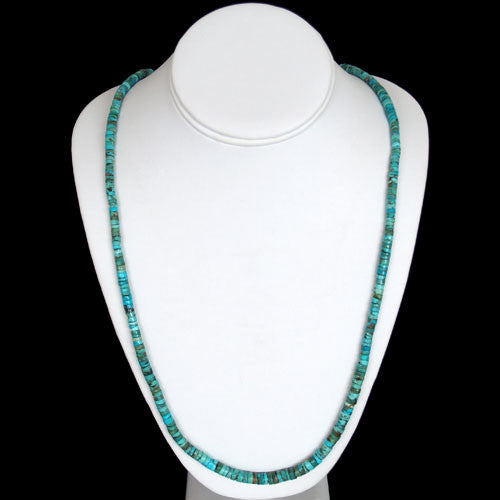
Santo Domingo Handmade Natural Gem Grade Blue Gem Turquoise Bead Necklace - Ray Lovato (#139)
$4,500.00
Artist: Ray Lovato
Total length: 33"
Wrap: 5 1/2"
Blue Gem turquoise jewelry is a rare, valuable and historic American treasure. Quality Blue Gem turquoise is gifted with a wide range of color, all of which are striking, full of wonder and pleasing to the eye. Very few large stones ever came out of the Blue Gem mine. The majority found were small, 1-mm "bleeder" veins and tiny nuggets, which are perfect for Ray Lovato's style of beads. Blue Gem turquoise jewelry was very popular in the late 1930's and 40's because it is extremely durable and very hard, which allows for a high polish and, unlike most turquoise, it doesn't easily change color. Ray and his beads are classic, high quality examples of Native American artistry.
Blue Gem Turquoise
Blue Gem turquoise occurs in argillized quartz monzonite cut by two limonite-stained sheer zones, one trending N 35 o W and dipping 75 o NE, the other trending N, 25 o E and dipping 55 o NW. An extensive breccia zone about 10 feet wide is developed between the two bounding sheers. Exceptionally good quality turquoise forms veins up to three-quarters of an inch thick along the shears. Pyrite-bearing quartz veins are closely associated with the turquoise.
The Blue Gem mine was at one time located deep underground, accessed by tunnels as deep as 800 feet. This is of interest because the Blue Gem Mine and the Bisbee Mine in Arizona are the only two mines (of which we are aware) that turquoise was found that deep in the earth. The Blue Gem mine was once developed in extensive underground workings and open stoops. An audit several hundred feet long on the main structure connected to numerous shorter tunnels and several open stoops. Directly above the main audit was a glory hole some 100 feet long.
Duke Goff first noted the Blue Gem deposit in 1934. It was subsequently leased from the Copper Canyon Mining Co. by the American Gem Co. of San Gabriel, CA., owned by Doc Wilson and his sons, Del and William. The company operated the property until 1941 when the outbreak of the war caused a shortage of experienced miners. Both Del and William Wilson were called into the Army for the duration of the war, and this compelled the closing of the mine. Consequently, the lease was allowed to lapse and work was abandoned. In 1950 Lee Hand and Alvin Layton of Battle Mountain leased the mine.
Production of turquoise at the Blue Gem lease in the early days of the operation was enormous. Although there is no exact information, it is reported that the output amounted to nearly
$1 million in rough turquoise. The mine is still active, although Duval Corp is currently in the center of a major copper deposit developing it.
Pyrite in Blue Gem is unusual to see but not unheard of. Very little large material ever came out of Blue Gem, the majority found was small 1-mm "bleeder" veins and tiny nuggets which was perfect for Zuni inlay and fine needlepoint, petit-point and snake-eyes jewelry. Blue Gem turquoise was very popular in the late 1930's and 40's and was commonly used in the Fred Harvey "tourist jewelry" that is so collectable today. Blue Gem turquoise is extremely hard and stands up well to the test of time.
Blue Gem turquoise is a rare, valuable and historic American treasure. Quality Blue Gem Turquoise has been gifted with a wide range and variety of color. Because Blue Gem turquoise is very hard, a high polish is associated with this stone, and unlike most turquoise, won't easily change color. This turquoise has a unique character and many different looks all of which are striking, full of wonder and pleasing to the eye.
Production of the mine started about 1934 and continued into the 1970's. Blue Gem Turquoise is still some of the finest turquoise ever found, and unlike most turquoise mines, (in which the majority mined is chalky and only usable if stabilized) most of the turquoise found there was of gem-quality. Today the Blue Gem mine is not viable; it sits in the middle of a huge mining operation. The emphasis is on precious metals and the extraction of turquoise is considered more of a hindrance in the mining process rather than an asset. Even the ever-popular "Dump Diving" for turquoise through the overburden is not tolerated due to the very real danger of becoming buried in a slide. Insurance factors, equipment hazards, high explosives and safety issues along with a lack of interest from the mining company keep Blue Gem turquoise unavailable to the world, at least for now.
About the artist:
The gift of humor is a blessing to those who have it, and to those of us exposed to the comic. From an early age, Steve and I have been blessed with the humor of Santa Domingo artist Ray Lovato. Not only does Ray create exceptional jewelry, he does it with wit and comedy. He always has an aura of happiness around him, and this attitude seems to spread, like a California fog, to those who know him. In addition to his artistic talents, Ray is also a gifted salesman. When he pulls up in front of the trading post we know that there is a good possibility that we will soon be parting company with our available cash.
Related legends:
Precious Stones
Turquoise; Precious stones have symbolic implications. For example, turquoise if a "collective term for all the precious stones, wealth, or mixed offerings. Good fortune is attributed to this stone." Both white shell and turquoise are emphasized in Kinaalda? More about this legend
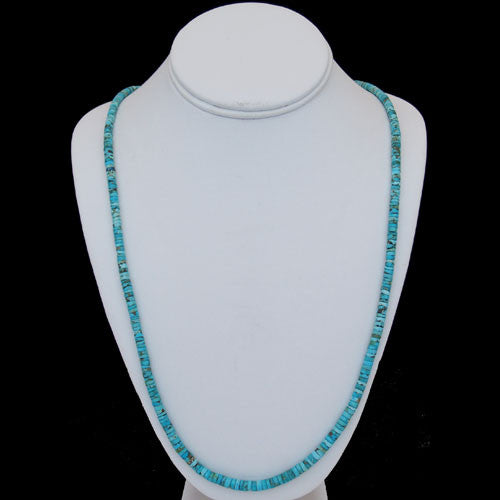
Santo Domingo Handmade Natural Gem Grade Lone Mountain Turquoise Tiny Bead Necklace - Ray Lovato (#142)
$7,500.00
Artist: Ray Lovato
Total Length: 35"
Wrap: 6 1/4"
It has always been our quest to seek out stashes of top grade natural turquoise; whether it’s rough material or individual cabochons with unique color and character. In this case we stumbled upon some small but powerfully potent trimmings from larger stones found and cut from the Lone Mountain turquoise mine near Tonopah, Nevada. The trimmings were perfect for Ray Lovato to re-cut and shape into some of the most exquisite beads we have ever seen from this mine. One never knows where a treasure might be found and what might inspire an artist like Ray.
Lone Mountain
The Lone Mountain turquoise mine is located near Tonapah, in Esmeralda County, Nevada. Since it is known for producing a high percentage of gem-grade turquoise, it is often referred to as a "sweet heart" mine. Originally established in 1920 by Lee Hand, the claim was initially called the Blue Jay Mining Lode. Later, after noting that so many other mines had been named Blue Jay, Hand changed its name to Lone Mountain.
In 1927, at a depth of about 40 feet, Bert Kopenhaver, who had leased the mine from Hand, found the beautiful spider web turquoise that made Lone Mountain one of the top mines in the Southwest. Although it has change hands several times over the years, the mine still produces a small amount of quality material. The Lone Mountain claim is currently owned by Gene Wadell and operated by Chris Lott.
Also known for exquisite, deep blue stones, the mine has historically produced some of the highest quality spider web turquoise in the world. "Fossil turquoise" has also been found in the mine. This was formed when ancient plants and seashells dissolved, leaving only cavities that were later filled with turquoise deposits. Additionally, turquoise nuggets in moss agate have been found. Because of its extraordinary hard nature, Lone Mountain turquoise has the ability to retain its rich color and is therefore a valuable addition to any jewelry collection.
About the artist:

The gift of humor is a blessing to those who have it, and to those of us exposed to the comic. From an early age, Steve and I have been blessed with the humor of Santa Domingo artist Ray Lovato. Not only does Ray create exceptional jewelry, he does it with wit and comedy. He always has an aura of happiness around him, and this attitude seems to spread, like a California fog, to those who know him. In addition to his artistic talents, Ray is also a gifted salesman. When he pulls up in front of the trading post we know that there is a good possibility that we will soon be parting company with our available cash.
Related legends:
Precious Stones
Turquoise; Precious stones have symbolic implications. For example, turquoise if a "collective term for all the precious stones, wealth, or mixed offerings. Good fortune is attributed to this stone." Both white shell and turquoise are emphasized in Kinaalda? More about this legend
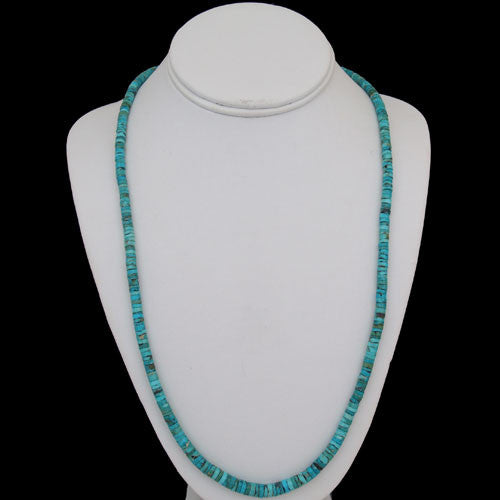
Santo Domingo Handmade Natural Gem Grade McGinnis Nevada Turquoise Necklace - Ray Lovato (#148)
$3,900.00
Artist: Ray Lovato
Length: 35 1/4"
Wrap: 5"
Mother Earth has an innate ability to produce the most visually appealing substances known to man. Such is the case with this subtle but attractive turquoise drawn from the home dirt of the McGinnis mine in central Nevada, USA. Ray Lovato is one of the most prolific Santa Domingo artists currently working with high-grade, natural turquoise. Match Lovato with McGinnis and you have a fabulous string of turquoise beads.
About the artist:

The gift of humor is a blessing to those who have it, and to those of us exposed to the comic. From an early age, Steve and I have been blessed with the humor of Santa Domingo artist Ray Lovato. Not only does Ray create exceptional jewelry, he does it with wit and comedy. He always has an aura of happiness around him, and this attitude seems to spread, like a California fog, to those who know him. In addition to his artistic talents, Ray is also a gifted salesman. When he pulls up in front of the trading post we know that there is a good possibility that we will soon be parting company with our available cash.
Related legends:
Precious Stones
Turquoise; Precious stones have symbolic implications. For example, turquoise if a "collective term for all the precious stones, wealth, or mixed offerings. Good fortune is attributed to this stone." Both white shell and turquoise are emphasized in Kinaalda? More about this legend
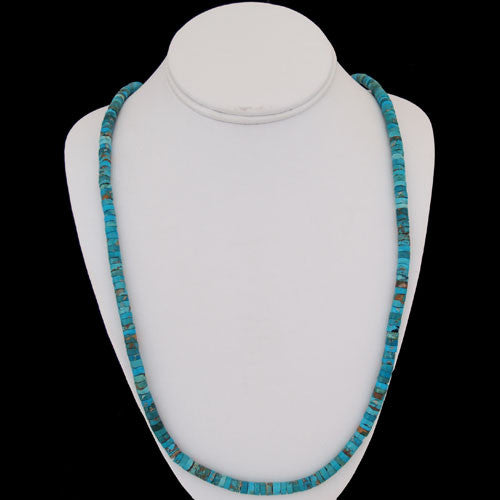
Santo Domingo Handmade Natural Gem Grade Royston Turquoise Bead Necklace - Ray Lovato (#137)
$4,995.00
Artist: Ray Lovato
Length: 38"
Wrap: 7"
Without a doubt, Santa Domingo lapidary artist Ray Lovato is a jokester and trickster. He is a funny guy, but when it comes to creating strands of beautiful beads, Ray is extraordinarily serious. We consider Ray the best of the old style, Native American lapidary artists. He retains the philosophy of maintaining meticulous craftsmanship and using high quality materials. As with this splendid strand of high-grade natural Royston turquoise beads, his attention to detail is distinctly obvious. Whether you are listening to Ray's wisecracks, witnessing his practical jokes or handling a length of his beads, a smile and laugh of delight will certainly come to you. After all, that is what Ray is about.
Royston Turquoise
The Royston Mining District lies on the Nye-Esmerelda County line, about 24 miles northwest of Tonopah, Nevada. In this area, turquoise mines are scattered for nearly a mile along a shallow canyon. Because it involves many small producers, the Royston district is one of the better-known turquoise mining areas in Nevada. Three of the district's more important turquoise mines are the Royal Blue, Bunker Hill and the Oscar Wehrend.
The Royal Blue mine constitutes the main turquoise workings in the district. This turquoise shows as fine-grained, altered porphyry, which is soft in places, although much of it has been hardened by silification. The turquoise is found principally in veinlets and seams, with minor lenses and nodules. The veinlets and lenses range from a fraction of an inch to more than an inch in thickness. Masses of turquoise, filling brecciated matrix, have, however, been found more than five inches thick. Lens shaped pieces of turquoise weighing an ounce or two are not uncommon, and one piece weighing nearly a pound and a half were found.
Royston turquoise ranges in color from dark and pale blue to various shades of green. Some of the dark blue turquoise has a slightly greenish cast, and some is nearly pure blue in color. The dark blue turquoise and that with a greenish cast are very fine grained and hard; the lighter colored ore is generally softer. The best turquoise is often found in limonite stained rock, and the pale blue, softer turquoise is found in light colored, softer porphyry. The quality of the best pure blue stones from the Royal Blue is equal to that found in any American mine and the matrix is especially fine.
The hard turquoise veins and nuggets are coated with a crust or stain of dark to light shading, and at times include a yellow limonite. This stain penetrates the turquoise along seams and branching cracks, producing attractive patterns and contrasts of color. Some large specimens have consisted of a patchwork of dark blue with a slightly greenish tint, marked in places with a very dark red-brown matrix. These cut gems can exhibit exceedingly wide variations of shading, and the matrix contrasts are often striking. Great spider webbing in green or blue nuggets and unusual scenic turquoise pieces are a hallmark of Royston
Two prospectors named Workman and Davis, who later sold the mine to William Petry for $3,000.00, discovered the mine in 1902. Petry improved the mine to the point of assuring its production, and, in 1907, sold it to The Himalaya Mining Co., which was owned by Julius Tannenbaum of Los Angeles and New York. Tannenbaum owned a number of mines in Nevada and California. During 1908 and 1909, the property was systematically and actively worked under the directions of Julius Goldsmith, Tanenbaum's son-in-law. Tannenbaum died suddenly about 1910, and Goldsmith hurried east to settle the estate. Shortly afterwards, he ordered operations abandoned and about 1911 sold the mine back to Petry. Petry and W. I. Miller, who had been Petry's mine boss, operated the mine for a time, and then leased it to Lee Hand and Bert Kopenhaver. Hand and Kopenhaver worked the mine dumps for a time, and then bought the mine outright from Petry. Kopenhaver later sold his share to Charley Bona. Hand and Bona worked the mine periodically, and in 1936 Bona sold his interest to Ted Johnson. In 1940 Johnson sold his share to Lee Hand.
The Otteson family now works the mine. The Otteson story began in 1944 with Lynn Otteson. Lynn brought his family to Nevada to mine turquoise and leased his first Royston claim from Lee Hand. At that time, Hand owned approximately 30 claims in the Royston district. The Otteson family has owned or leased turquoise claims in this district for the past 60 years. The Royal Blue mine has been one of the major turquoise producers in the state of Nevada. For some time, the mine produced as much as 1,250 pounds of turquoise a month, and several times has exceeded that amount.
Petry, at the time he sold the mine to Hand and Kopenhaver, declared that the Royal Blue had produced more gem quality turquoise than any mine in the United States. He placed the value of cut stones taken from the mine at more than $5 million. There is no adequate estimate of the value of gems produced from the mine in the years since that time.
The Bunker Hill is about half a mile north of The Royal Blue. In this mine, turquoise occurs in altered quartzite and ranges from royal blue to greenish blue with brown with white matrix. Turquoise is mainly in the form of slabs from 1/16 of an inch to a full inch thick. The mine was discovered in 1927 by Roy Palfreyman and Bert Kopenhaver, and was originally opened as a small shaft about 20 feet deep. As the turquoise was unearthed, the shaft was widened along the seam into a long stope, which was eventually opened into a glory hole. Polfreyman and Kopenhaver took out about $30,000 worth of turquoise, then sold to the owners of the Royal Blue mine, who produced about $75,000 worth of material. The mine eventually was incorporated into the Royal Blue group of claims.
The Oscar Wehrend mine, in the Royston district, is about 1/3 of a mile from the main workings of the Royal Blue. The turquoise is in highly altered rocks, where it forms seams, coatings and nodules as large as 2 inches thick. It is mostly soft, pale, and not of very good quality. Its color and hardness can, however, be improved by artificial means. Oscar Wehrend discovered the deposit in 1909, but Lee Hand conducted much of the work. Production from the property has been small.
The Royston Mine was originally worked as a silver mine in the late 1800s, Large deposits of high quality turquoise led Tiffany's of New York to incorporate quality green and blue turquoise stones from the Royston Hills into their jewelry lines prior to WWII. There was a brief surge of Royston turquoise production in the 1970s, and the Royston district is still producing limited amounts of high quality turquoise. The turquoise currently being produced from the Royston district is mined by Dean and Danny Otteson, and is coming from the Royal Royston claim.
About the artist:
The gift of humor is a blessing to those who have it, and to those of us exposed to the comic. From an early age, Steve and I have been blessed with the humor of Santa Domingo artist Ray Lovato. Not only does Ray create exceptional jewelry, he does it with wit and comedy. He always has an aura of happiness around him, and this attitude seems to spread, like a California fog, to those who know him. In addition to his artistic talents, Ray is also a gifted salesman. When he pulls up in front of the trading post we know that there is a good possibility that we will soon be parting company with our available cash.
See full biography
Related legends:
Precious Stones
Turquoise; Precious stones have symbolic implications. For example, turquoise if a "collective term for all the precious stones, wealth, or mixed offerings. Good fortune is attributed to this stone." Both white shell and turquoise are emphasized in Kinaalda? More about this legend
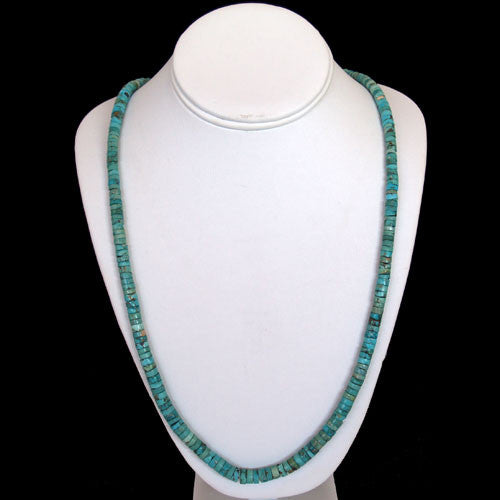
Santo Domingo Handmade Natural Gem Grade Royston Turquoise Bead Necklace - Ray Lovato (#140)
$4,500.00
Artist: Ray Lovato
Total length: 33 1/2"
Wrap: 4"
Ray Lovato is surely one of the characters of Twin Rocks Trading Post. As Barry and I will absolutely affirm, Ray never leaves the trading post without making an impression. Whether it is his off-color jokes or his on-color turquoise, we are always happier having seen him. This week he brought humor and a great strand of Royston turquoise beads to make us smile. We feel we can never have too many sets of his beads, since we wonder how long he can continue to produce.
Royston Turquoise
The Royston Mining District lies on the Nye-Esmerelda County line, about 24 miles northwest of Tonopah, Nevada. In this area, turquoise mines are scattered for nearly a mile along a shallow canyon. Because it involves many small producers, the Royston district is one of the better-known turquoise mining areas in Nevada. Three of the district's more important turquoise mines are the Royal Blue, Bunker Hill and the Oscar Wehrend.
The Royal Blue mine constitutes the main turquoise workings in the district. This turquoise shows as fine-grained, altered porphyry, which is soft in places, although much of it has been hardened by silification. The turquoise is found principally in veinlets and seams, with minor lenses and nodules. The veinlets and lenses range from a fraction of an inch to more than an inch in thickness. Masses of turquoise, filling brecciated matrix, have, however, been found more than five inches thick. Lens shaped pieces of turquoise weighing an ounce or two are not uncommon, and one piece weighing nearly a pound and a half were found.
Royston turquoise ranges in color from dark and pale blue to various shades of green. Some of the dark blue turquoise has a slightly greenish cast, and some is nearly pure blue in color. The dark blue turquoise and that with a greenish cast are very fine grained and hard; the lighter colored ore is generally softer. The best turquoise is often found in limonite stained rock, and the pale blue, softer turquoise is found in light colored, softer porphyry. The quality of the best pure blue stones from the Royal Blue is equal to that found in any American mine and the matrix is especially fine.
The hard turquoise veins and nuggets are coated with a crust or stain of dark to light shading, and at times include a yellow limonite. This stain penetrates the turquoise along seams and branching cracks, producing attractive patterns and contrasts of color. Some large specimens have consisted of a patchwork of dark blue with a slightly greenish tint, marked in places with a very dark red-brown matrix. These cut gems can exhibit exceedingly wide variations of shading, and the matrix contrasts are often striking. Great spider webbing in green or blue nuggets and unusual scenic turquoise pieces are a hallmark of Royston
Two prospectors named Workman and Davis, who later sold the mine to William Petry for $3,000.00, discovered the mine in 1902. Petry improved the mine to the point of assuring its production, and, in 1907, sold it to The Himalaya Mining Co., which was owned by Julius Tannenbaum of Los Angeles and New York. Tannenbaum owned a number of mines in Nevada and California. During 1908 and 1909, the property was systematically and actively worked under the directions of Julius Goldsmith, Tanenbaum's son-in-law. Tannenbaum died suddenly about 1910, and Goldsmith hurried east to settle the estate. Shortly afterwards, he ordered operations abandoned and about 1911 sold the mine back to Petry. Petry and W. I. Miller, who had been Petry's mine boss, operated the mine for a time, and then leased it to Lee Hand and Bert Kopenhaver. Hand and Kopenhaver worked the mine dumps for a time, and then bought the mine outright from Petry. Kopenhaver later sold his share to Charley Bona. Hand and Bona worked the mine periodically, and in 1936 Bona sold his interest to Ted Johnson. In 1940 Johnson sold his share to Lee Hand.
The Otteson family now works the mine. The Otteson story began in 1944 with Lynn Otteson. Lynn brought his family to Nevada to mine turquoise and leased his first Royston claim from Lee Hand. At that time, Hand owned approximately 30 claims in the Royston district. The Otteson family has owned or leased turquoise claims in this district for the past 60 years. The Royal Blue mine has been one of the major turquoise producers in the state of Nevada. For some time, the mine produced as much as 1,250 pounds of turquoise a month, and several times has exceeded that amount.
Petry, at the time he sold the mine to Hand and Kopenhaver, declared that the Royal Blue had produced more gem quality turquoise than any mine in the United States. He placed the value of cut stones taken from the mine at more than $5 million. There is no adequate estimate of the value of gems produced from the mine in the years since that time.
The Bunker Hill is about half a mile north of The Royal Blue. In this mine, turquoise occurs in altered quartzite and ranges from royal blue to greenish blue with brown with white matrix. Turquoise is mainly in the form of slabs from 1/16 of an inch to a full inch thick. The mine was discovered in 1927 by Roy Palfreyman and Bert Kopenhaver, and was originally opened as a small shaft about 20 feet deep. As the turquoise was unearthed, the shaft was widened along the seam into a long stope, which was eventually opened into a glory hole. Polfreyman and Kopenhaver took out about $30,000 worth of turquoise, then sold to the owners of the Royal Blue mine, who produced about $75,000 worth of material. The mine eventually was incorporated into the Royal Blue group of claims.
The Oscar Wehrend mine, in the Royston district, is about 1/3 of a mile from the main workings of the Royal Blue. The turquoise is in highly altered rocks, where it forms seams, coatings and nodules as large as 2 inches thick. It is mostly soft, pale, and not of very good quality. Its color and hardness can, however, be improved by artificial means. Oscar Wehrend discovered the deposit in 1909, but Lee Hand conducted much of the work. Production from the property has been small.
The Royston Mine was originally worked as a silver mine in the late 1800s, Large deposits of high quality turquoise led Tiffany's of New York to incorporate quality green and blue turquoise stones from the Royston Hills into their jewelry lines prior to WWII. There was a brief surge of Royston turquoise production in the 1970s, and the Royston district is still producing limited amounts of high quality turquoise. The turquoise currently being produced from the Royston district is mined by Dean and Danny Otteson, and is coming from the Royal Royston claim.
About the artist:
The gift of humor is a blessing to those who have it, and to those of us exposed to the comic. From an early age, Steve and I have been blessed with the humor of Santa Domingo artist Ray Lovato. Not only does Ray create exceptional jewelry, he does it with wit and comedy. He always has an aura of happiness around him, and this attitude seems to spread, like a California fog, to those who know him. In addition to his artistic talents, Ray is also a gifted salesman. When he pulls up in front of the trading post we know that there is a good possibility that we will soon be parting company with our available cash.
Related legends:
Precious Stones
Turquoise; Precious stones have symbolic implications. For example, turquoise if a "collective term for all the precious stones, wealth, or mixed offerings. Good fortune is attributed to this stone." Both white shell and turquoise are emphasized in Kinaalda? More about this legend
